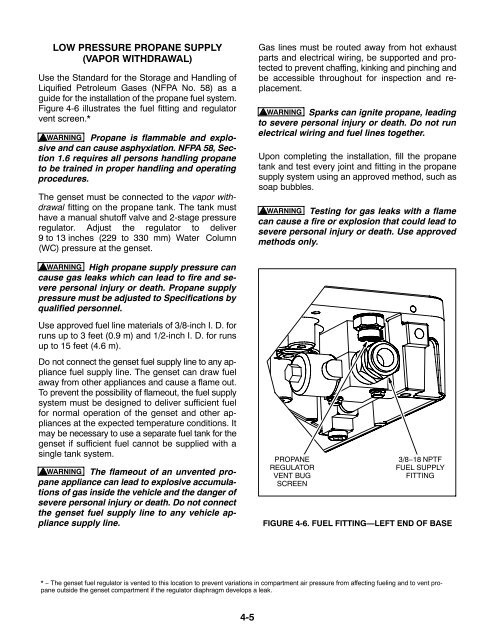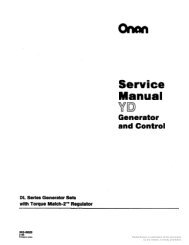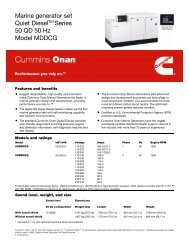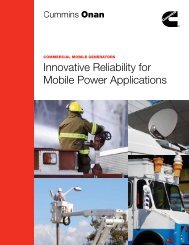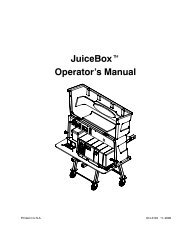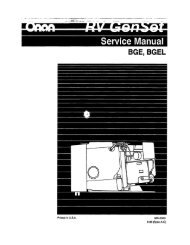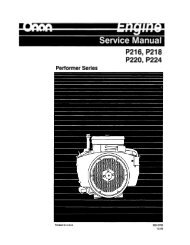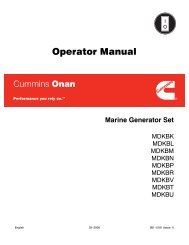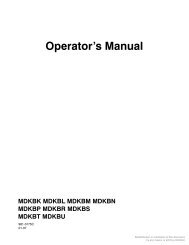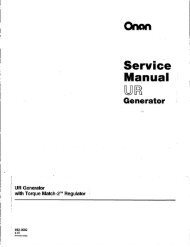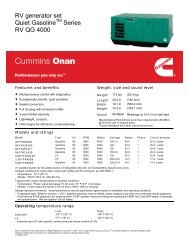Caution: This document contains mixed page sizes ... - Cummins Onan
Caution: This document contains mixed page sizes ... - Cummins Onan
Caution: This document contains mixed page sizes ... - Cummins Onan
You also want an ePaper? Increase the reach of your titles
YUMPU automatically turns print PDFs into web optimized ePapers that Google loves.
LOW PRESSURE PROPANE SUPPLY<br />
(VAPOR WITHDRAWAL)<br />
Use the Standard for the Storage and Handling of<br />
Liquified Petroleum Gases (NFPA No. 58) as a<br />
guide for the installation of the propane fuel system.<br />
Figure 4-6 illustrates the fuel fitting and regulator<br />
vent screen.*<br />
WARNING Propane is flammable and explosive<br />
and can cause asphyxiation. NFPA 58, Section<br />
1.6 requires all persons handling propane<br />
to be trained in proper handling and operating<br />
procedures.<br />
The genset must be connected to the vapor withdrawal<br />
fitting on the propane tank. The tank must<br />
have a manual shutoff valve and 2-stage pressure<br />
regulator. Adjust the regulator to deliver<br />
9 to 13 inches (229 to 330 mm) Water Column<br />
(WC) pressure at the genset.<br />
Gas lines must be routed away from hot exhaust<br />
parts and electrical wiring, be supported and protected<br />
to prevent chaffing, kinking and pinching and<br />
be accessible throughout for inspection and replacement.<br />
WARNING Sparks can ignite propane, leading<br />
to severe personal injury or death. Do not run<br />
electrical wiring and fuel lines together.<br />
Upon completing the installation, fill the propane<br />
tank and test every joint and fitting in the propane<br />
supply system using an approved method, such as<br />
soap bubbles.<br />
WARNING Testing for gas leaks with a flame<br />
can cause a fire or explosion that could lead to<br />
severe personal injury or death. Use approved<br />
methods only.<br />
WARNING High propane supply pressure can<br />
cause gas leaks which can lead to fire and severe<br />
personal injury or death. Propane supply<br />
pressure must be adjusted to Specifications by<br />
qualified personnel.<br />
Use approved fuel line materials of 3/8-inch I. D. for<br />
runs up to 3 feet (0.9 m) and 1/2-inch I. D. for runs<br />
up to 15 feet (4.6 m).<br />
Do not connect the genset fuel supply line to any appliance<br />
fuel supply line. The genset can draw fuel<br />
away from other appliances and cause a flame out.<br />
To prevent the possibility of flameout, the fuel supply<br />
system must be designed to deliver sufficient fuel<br />
for normal operation of the genset and other appliances<br />
at the expected temperature conditions. It<br />
may be necessary to use a separate fuel tank for the<br />
genset if sufficient fuel cannot be supplied with a<br />
single tank system.<br />
WARNING The flameout of an unvented propane<br />
appliance can lead to explosive accumulations<br />
of gas inside the vehicle and the danger of<br />
severe personal injury or death. Do not connect<br />
the genset fuel supply line to any vehicle appliance<br />
supply line.<br />
PROPANE<br />
REGULATOR<br />
VENT BUG<br />
SCREEN<br />
3/8−18 NPTF<br />
FUEL SUPPLY<br />
FITTING<br />
FIGURE 4-6. FUEL FITTING—LEFT END OF BASE<br />
* − The genset fuel regulator is vented to this location to prevent variations in compartment air pressure from affecting fueling and to vent propane<br />
outside the genset compartment if the regulator diaphragm develops a leak.<br />
4-5


